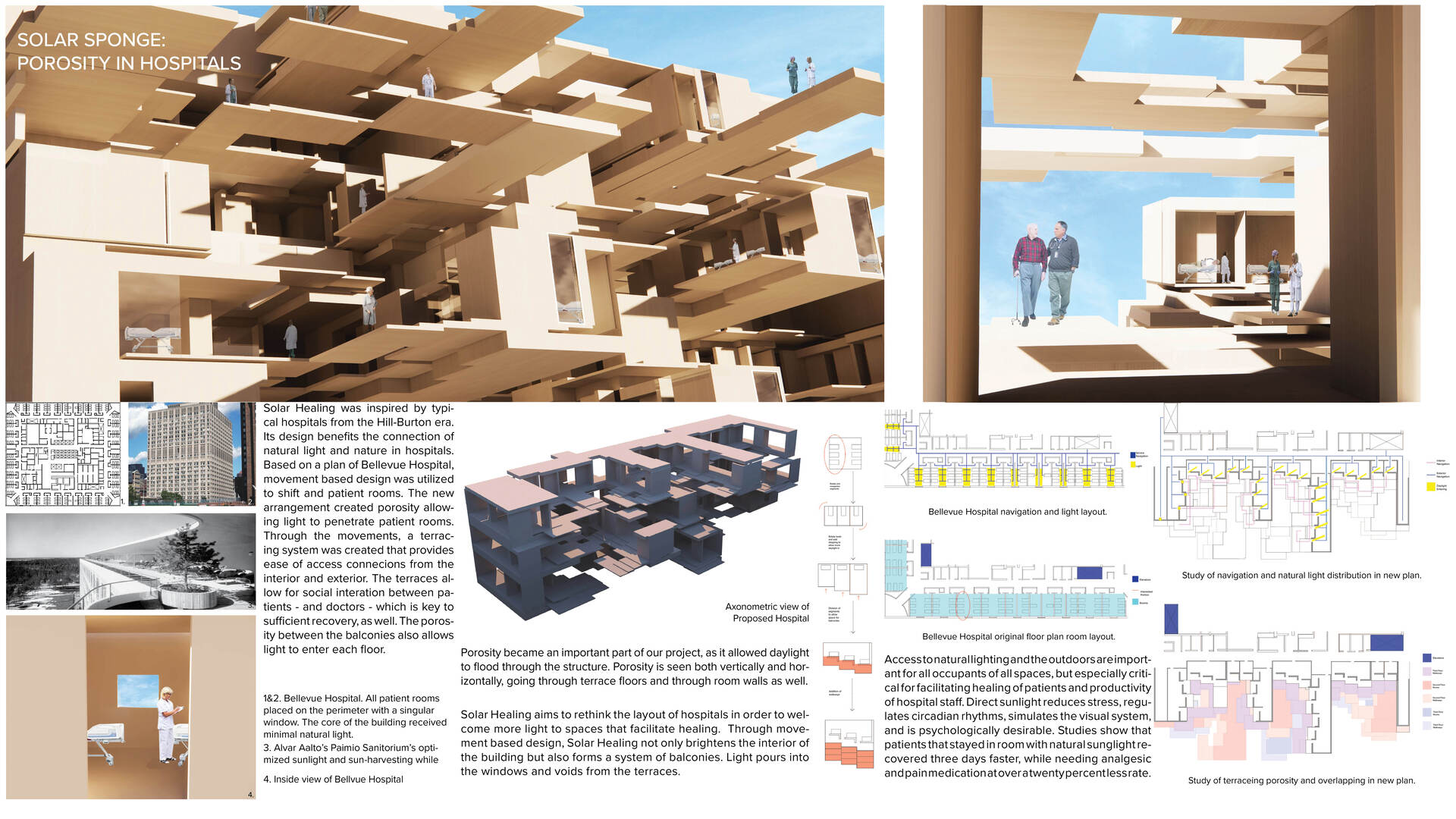Project Description
Solar Sponge aims to rethink the layout of hospitals in order to bring in more light to spaces that facilitate healing. Through movement based design, our project not only lightens up the interior of the building but also forms a system of balconies. Light pours in from the windows and from the voids in the terraces. Access to natural light and the outdoors are important for all occupants of all spaces, but especially critical for facilitating healing of patients and productivity of hospital staff. Direct sunlight is necessary for healing because it reduces stress, regulates circadian rhythms, simulates the visual system, and is psychologically desirable. Furthermore, humans’ positive response to the outdoors is partially genetic (Behringer 3). Studies even prove that patients who stayed in sunny rooms recovered in 16.9 days on average, while patients in dull rooms averaged a 19.5 day stay (Beauchemin, K..M. et al). The same study found that mortality rates in sunny rooms were significantly lower than the mortality rate in dull rooms. In dull rooms, the mortality rate was 35/335. In sunny rooms, it dropped to 21/293. This research drove our design to incorporate access to nature and sunlight in patient rooms. Patients housed in natural light reported 22% less analgesic medication per hour and 21% less pain medication (Walch, Jeffrey M. et al ). Daylight also improves the experience of medical personnel. In 1991, a study found that errors were reduced as light illumination increased. Daylight reduces stress while improving energy. Studies show this combination improves productivity by 6-16% in workplaces (Brain). Furthermore, natural light creates superior color rendition and edge detection over LED and incandescent light. Natural light even has the potential to improve visibility on operating tables (Brain). Alvar Aalto championed humanistic approaches to hospital design in his Paimio Sanitorium. Built in Finland between 1929 and 1933, the sanatorium’s design optimized sunlight and sun-harvesting. Terraces and roof gardens allowed patients to access nature (Behringer 38). Although Aalto was designing sunny spaces specifically to cure tuberculosis, terraced hospitals became a popular typology until the second World War. Many cultural and technological influences have contributed to a shift in hospital typologies in the US. By the mid-20th century, low energy cost and the option of fluorescent light made denser buildings plausible; daylight was no longer the primary source of light (Behringer 59). During the Hill-Burton era, thousands of hospitals were constructed in the US. These new hospitals were built based on preset floor plans and standards for facilities. A core support zone was adopted to optimize staff and patient movement. This hospital typology isolated both patients and staff from daylight and nature. Other developed countries with healthcare systems comparable to the United States have kept access to views, light and nature in their hospital typologies. In Europe, hospitals are required to have operable windows and narrow configurations that optimize access to daylight (Behringer 60). Various typologies are used to achieve a connection to the outdoors, such as perforated blocks or narrow wings. In Solar Healing, we started with an analysis of a typical US hospital from the Hill-Burton era. We chose Bellevue Hospital in New York City. All patient rooms were on the perimeter of the plan with a singular window. The core of the building received little to no natural light. Solar Healing is based on research that proves the benefits of natural light and a connection to nature in hospitals. Based on a plan of Bellevue, we use movement based design to shift and rotate rooms in various dimensions. This new arrangement of rooms created porosity in a previously monolithic form. This porosity allows light to penetrate not only into patient rooms but also staff areas. In order to integrate indoors and outdoors, a system of terraces was added. This outdoor space is accessible to every patient and staff member. Due to the connectivity between the interior and the terraces, every patient and staff member can access a private area. However, the terraces are all connected, providing potential for social gatherings. The porosity between the balconies also allows light to enter every floor.
